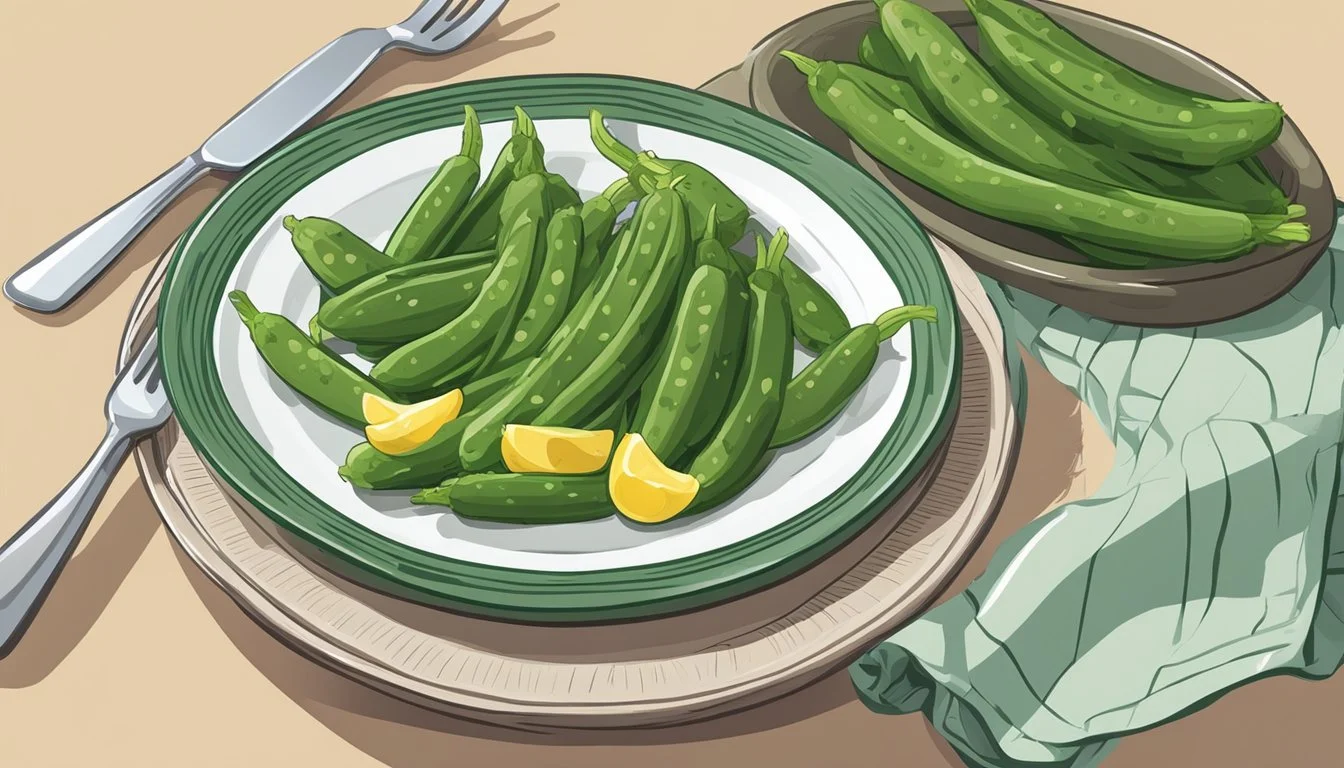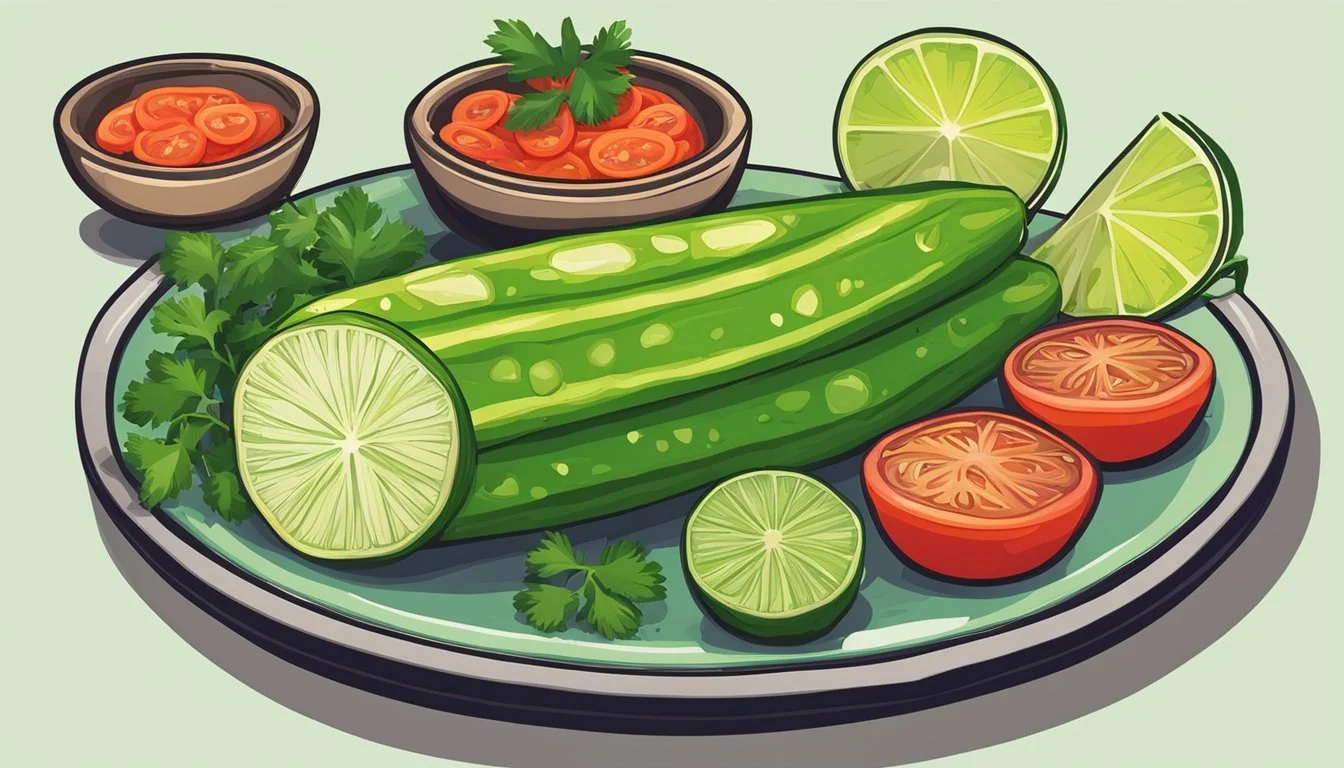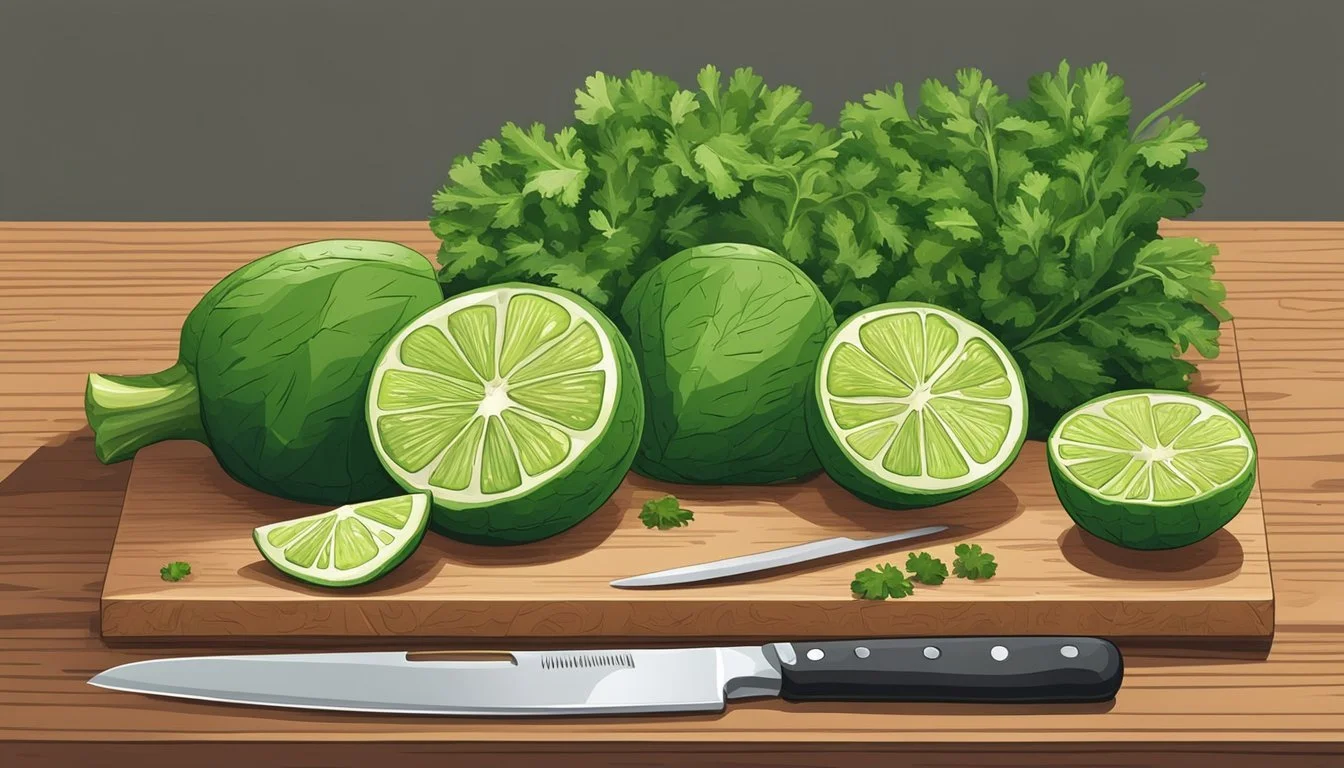How do you eat a nopalito?
A Guide to Enjoying this Traditional Delicacy
Nopalitos, the edible young pads of the prickly pear cactus, offer a unique culinary experience deeply rooted in Mexican cuisine. These succulent pads are known for their crisp yet chewy texture and a flavor reminiscent of green beans with a hint of lemon. Before being consumed, nopalitos require careful preparation to remove their spines and any residual bitterness. Once cleaned, they can be cut into strips or diced, transforming into a versatile ingredient that can enhance salads, stews, and scrambled eggs, or stand as the focal point of a dish.
Traditionally, nopalitos are often cooked to eliminate their natural slimy texture, similar to that of okra, and to bring out their subtle, vegetal flavor. The cooking process may involve boiling the nopalitos with seasonings or grilling them to add a smoky note. They can be served hot or cold, and their ability to absorb other flavors makes them excellent in marinated dishes. Nopalitos are not only prized for their taste but also for their health benefits, as they are rich in vitamins, minerals, fiber, and antioxidants.
Nutritional Profile of Nopalitos
Nopalitos, the tender pads of the Nopal cactus, are not only a staple in Mexican cuisine but also a rich source of nutrients with potential health benefits.
Health Benefits
Nopalitos are known for their potential health-promoting properties. They may play a role in reducing blood sugar levels, which is beneficial for individuals managing diabetes. The fibrous content in nopalitos helps to balance cholesterol levels, possibly reducing the risk of heart disease. Studies have also indicated that nopalitos might have anti-inflammatory properties, which can aid in reducing inflammation-related conditions.
Dietary Fiber Content
A significant component of nopalitos is dietary fiber. The high fiber content aids digestion and can help prevent constipation. It also contributes to the feeling of fullness and can thus support weight management efforts. Fiber is crucial in the diet as it assists in stabilizing blood glucose and cholesterol levels.
Vitamins and Minerals
Nopalitos are a source of several essential vitamins and minerals:
Vitamin A: Important for immune function, vision, and skin health.
Calcium: Vital for bone health and muscular function.
Magnesium: Supports metabolic health and is needed for more than 300 biochemical reactions in the body.
Potassium: Helps maintain healthy blood pressure and is important for heart and muscle function.
Caloric Information
In terms of caloric content, nopalitos are low in calories, which makes them an excellent addition to a diet for weight control. Their low cholesterol content further adds to their appeal as a heart-healthy food. The nutritional facts indicate a clear benefit for those concerned with obesity or high cholesterol.
Preparation Basics
Preparing nopalitos involves meticulous cleaning to remove the spines and a proper cutting technique to enjoy them in a variety of dishes. These initial steps are essential to ensure the cactus paddles are safe and pleasant to eat.
Cleaning and De-Spining
The first step in preparing nopalitos is to clean and de-spine the cactus paddles. This process requires a sharp knife and careful attention to detail to avoid any pricks from the spines. Here are the steps to clean nopalitos:
Wash the nopales under running water to remove any dirt.
Slide the knife under the spines, cutting them out along with the small bumps from which they grow.
Repeat on both sides of the nopal until it is completely devoid of spines.
Rinse the nopales again to wash away any remaining spines or debris.
Fresh nopales can have a sticky residue similar to okra when cut, but this texture is normal and diminishes with cooking.
Cutting Techniques
Once the nopales are clean and spine-free, the next step is to cut them into the desired shape for your recipe. Here are the common cutting techniques for nopalitos:
Dicing is suitable for salads and salsas where small, bite-sized pieces are preferred.
Cutting Style Dimension Best Used For Dice 1/2 inch cubes Salads, Salsas Julienne 1/8 inch thick strips Sautees, Garnishes Strips Lengthwise strips Grilling, Side Dishes
Strips or slivers are ideal for sautéing or including in other dishes where a larger, more textured piece is desirable.
The cutting technique should be chosen to match the final dish's desired texture and presentation. It is vital to maintain consistency in the size of the pieces for even cooking.
Cooking Methods
Nopalitos, the edible pads of the prickly pear cactus, can be prepared through various cooking methods which enhance their flavor and texture. Each method complements the nopalitos differently, offering a range of options for incorporating them into meals.
Boiling Nopalitos
Boiling is often the first step in preparing nopalitos to remove their viscous sap and tenderize them. They should be cleaned and cut into pieces, then placed in a pot of salted water. The water should be brought to a boil before reducing the heat to allow the nopalitos to simmer. Depending on their thickness, they typically require 15-20 minutes to become tender.
Grilling Nopalitos
Grilled nopales have a smoky flavor that's ideal for summer dishes or as an accompaniment to meats. To grill nopalitos, one should clean them and remove any spines or eyes. They can be placed directly on a preheated grill and cooked until charred marks appear, usually taking about 5 minutes per side. The nopalitos should be turned occasionally to ensure even cooking.
Sautéing Nopalitos
For a quick and flavorful dish, nopalitos can be sautéed in a skillet with a bit of oil. Sautéing allows them to retain a bit of crunch and brings out a natural, earthy flavor. It's common to add sautéed onion, garlic, and jalapeño to the skillet, creating a robust taste profile. Typically, the nopalitos are cooked over medium-high heat, stirring occasionally, until they reach the desired tenderness, which usually takes around 10 minutes.
Traditional Nopalito Recipes
Nopalitos, or diced prickly pear cactus pads, are a staple in Mexican cuisine. They offer a delicately tart and vegetal flavor profile, similar to green beans yet unique to its kind. Here are some traditional recipes that include nopalitos as a central ingredient.
Nopalito Salad
To prepare Nopalito Salad, one typically starts by boiling the nopalitos until tender. They are then chopped and combined with other fresh ingredients such as tomatoes, onions, (What wine goes well with onions?) and cilantro (how long does cilantro last?). A simple dressing of olive oil, lime juice, oregano, and salt is often used to enhance the flavors.
Ingredients:
Cooked nopalitos
Chopped tomatoes
Diced onions
Fresh cilantro
Olive oil
Lime juice
Oregano
Salt
Method:
Toss the nopalitos, tomatoes, onions, and cilantro together in a bowl.
In a separate jar, shake the olive oil, lime juice, oregano, and salt to mix the dressing.
Pour over the salad and toss to coat evenly.
Nopalitos with Scrambled Eggs
Nopalitos with Scrambled Eggs, known as Huevos con Nopalitos, is a hearty breakfast dish. The nopalitos are sautéed with onions and mixed into scrambled eggs.
Ingredients:
Sautéed nopalitos
Diced onions
Whisked eggs
Cooking oil
Method:
Sauté the onions, then add the nopalitos and continue cooking for a few minutes.
Pour in the eggs and scramble everything together until the eggs are cooked through.
Nopalito Tacos
For Nopalito Tacos, seasoned nopalitos are used as a taco filling, often accompanied by other toppings such as cheese, sour cream, and salsa.
Ingredients:
Seasoned, cooked nopalitos
Corn tortillas
Crumbled cheese
Sour cream
Fresh salsa
Method:
Warm the tortillas on a griddle or pan.
Fill each tortilla with nopalitos and any additional toppings as desired.
Serve immediately.
Each recipe showcases the versatility of nopalitos and their ability to absorb and complement the flavors of other ingredients, providing a tasty and nutritious option for various meals.
Ingredients and Flavor Pairings
Nopalitos, derived from the prickly pear cactus, have a unique, subtly tangy flavor that pairs well with a variety of ingredients. This section outlines specific seasonings, vegetables, and proteins that complement the taste and texture of nopalitos, enhancing their culinary appeal.
Common Seasonings
Salt: It is essential for balancing the slight bitterness of nopalitos.
Lime Juice: Adds a bright, acidic contrast to the nopalitos' flavors.
Cilantro: Brings freshness and a hint of citrus that marries well with the cactus pads.
Garlic: Offers a pungent kick, augmenting the inherent flavors of the nopalitos.
Olive Oil: Ensures a smooth texture and pairs nicely with nopalitos' earthy taste.
Vegetable Companions
Tomato: Provides sweetness and moisture, often used in salsas with nopalitos.
Onion and Red Onion: They offer a sharp bite that contrasts the succulence of the cactus.
Jalapeños: Contribute heat, which complements the nopalitos without overpowering them.
Avocado: Delivers creaminess and richness, making it a popular pairing for nopalitos in salads.
Corn Kernels: Impart sweetness and a satisfying crunch in dishes with nopalitos.
Green Beans: They provide a snappy texture that stands up next to the tender nopalitos.
Protein Pairings
Pork: A common meat pairing, pork's savory depth harmonizes with the qualities of nopalitos.
In recipes, they often look for proteins that won't overshadow the delicate taste of the nopalitos. Therefore, lighter meats or those that can be seasoned to complement the cactus pieces are preferable.
Serving and Presentation
Nopalitos, the young, tender pads of the prickly pear cactus, are a versatile ingredient in Mexican cuisine. Their unique flavor and texture can be a standout feature when thoughtfully incorporated into various dishes, from sides to main courses, and even as a garnish.
As a Side Dish
In Mexican cuisine, nopalitos often appear as a side dish, where they can be served raw or cooked. When served raw, they are typically sliced into strips and marinated with lime juice and spices, often complemented by a sprinkle of paprika. Cooked nopalitos might be presented as part of a salad, tossed with tomatoes, onions, and cilantro, and dressed with a blend of olive oil, lime juice, oregano, and salt.
Raw Preparation:
Slice nopalitos into strips
Marinate with lime juice and spices
Cooked Preparation:
Toss with tomatoes, onions, cilantro
Dress with olive oil, lime juice, oregano, salt
Incorporation in Main Courses
Nopalitos lend their distinct texture and taste to main courses, where they are often incorporated into stews or sautéed with other vegetables. They are also a frequent addition to Mexican dishes such as quesadillas and tostadas, providing a succulent, slightly tangy bite. Stews with nopalitos simmer to a flavorful harmony, as the nopalitos absorb the other flavors in the dish.
Sautéed:
Combine with corn and peppers
Squeeze fresh lime juice
Stews and Mexican Dishes:
Add to quesadillas or tostadas
Cook until flavors meld
Garnishing Tips
To garnish with nopalitos, one can slice them into thin strips or small cubes for a refreshing and visually appealing finish. Their crisp texture and vibrant green hue add not only a burst of flavor but also a pop of color that can enhance the presentation of traditional Mexican dishes.
Garnish Uses:
Slice into thin strips or cubes
Add to the top of finished dishes for texture and color
Special Considerations
When preparing nopalitos, it's important for one to consider individual health sensitivities, the unique texture of the plant, and the best practices for storage to ensure freshness.
Allergies and Sensitivities
Although rare, some individuals may experience allergic reactions to nopalitos. Similar to other foods, if one encounters symptoms such as itching, swelling, or difficulty breathing after consuming nopalitos, they should seek medical attention. Moreover, always introduce nopalitos into the diet gradually, paying attention to the body's response.
Consistency Management
Nopalitos are known for their slimy consistency, often compared to okra when sliced. To manage the slime, one should cook the nopalitos until the liquid released has evaporated. Alternatively, for those desiring to consume them raw, one might rinse the slices with cold water or combine them with acidic ingredients like lime juice to reduce slime.
Storage and Shelf Life
Fresh nopalitos should be refrigerated to prolong their shelf life, which typically spans up to a week. They should be stored in an airtight container or wrapped tightly to prevent dehydration. Proper storage inhibits spoilage and maintains the integrity of the nopalitos' texture and flavor.
Cultural Significance
Nopalitos embody a rich cultural tradition within Mexican cuisine and have experienced a growing appreciation in culinary communities globally.
Nopalitos in Mexican Cuisine
Nopalitos, the tender segments of the prickly pear cactus, hold an esteemed place in Mexican cuisine. They are often featured as a Mexican dish in the form of salads, tacos, and as an accompaniment to meats. A Mexican salad incorporating nopalitos typically includes chopped tomatoes, onions, cilantro, and is dressed with lime juice and spices. This illustrates the vegetable's versatility and its integration into the daily diet across Mexico. Nopalitos not only represent a vital source of nutrients but also carry the weight of culinary heritage, being a staple in Mexican kitchens for centuries.
Global Adoption
The use of nopalitos has expanded beyond Mexico, permeating the culinary landscapes of the Southwestern United States and even making appearances in Mediterranean diets. Chefs across various culinary traditions have embraced this ingredient for its unique flavor profile and adaptability. In the Southwestern United States, nopalitos frequently appear in vegetarian dishes (What wine goes well with vegetarian dishes?), stews, and breakfast plates, integrating seamlessly into the local palate which favors robust and hearty flavors. Their emergence in Mediterranean cuisine underscores their global appeal and versatility, as more kitchens around the world seek to adopt traditional ingredients from diverse cultures into their culinary repertoire.
Advanced Tips
In mastering the art of preparing and serving nopalitos, there are techniques to enhance flavor, reduce prep time, and incorporate culinary innovations that elevate this versatile vegetable to gourmet status.
Enhancing Flavor
Chefs often recommend using extra virgin olive oil and kosher salt when seasoning nopalitos to bring out their natural, earthy taste. Using high-quality ingredients such as these can significantly boost the overall flavor profile of the dish. For a more complex taste, one might add:
A squeeze of fresh lime juice for a zesty tang.
A pinch of spices like cumin or paprika to accentuate the nopalitos' freshness.
Reducing Prep Time
To save on prep time without sacrificing the nopalitos' texture and taste:
Clean cactus paddles ahead of time and store them properly.
Pre-slice the nopalitos for future use and keep them in an airtight container in the refrigerator.
By having these ingredients ready, one can reduce both prep time and total time when creating dishes on the fly.
Culinary Innovations
Nopalitos are not only a green vegetable; they're a superfood with antiviral and anti-inflammatory properties that can be introduced into a myriad of culinary creations. Some innovative ways they are used include:
Incorporating finely chopped nopalitos into sushi rolls for an unexpected crunch and nutrient boost.
Blending them into smoothies with other vegetables for a morning superfood kick.
By exploring these advanced tips, chefs can discover new dimensions in flavor, save time in the kitchen, and introduce nopalitos into unexpected culinary contexts.
Conclusion
Nopalitos, the tender pads of the prickly pear cactus, offer a culinary adventure for those seeking to explore traditional Mexican cuisine. Consumed either fresh or cooked, these succulent pieces provide versatility in various dishes. They are commonly paired with ingredients such as onions, tomatoes, and asparagus.
When preparing nopalitos, chefs advise the careful removal of the spines, followed by slicing them into thin strips. They can be enjoyed raw, similar in texture to asparagus, enhanced with a squeeze of lime juice and a sprinkle of seasonings. In contrast, for a heartier meal, they can be sautéed with a white onion and tomatoes, melding the flavors into a delectable mix.
Here's a quick summary of ways to incorporate nopalitos in meals:
Raw: Tossed in salads or as appetizers with lime and spices.
Sautéed: Combined with onions and tomatoes for a savory side dish.
Salsa: Chopped nopalitos mixed into a cactus salsa as a unique dip.
Nopalitos not only add a unique taste and texture to dishes but also contribute nutritional benefits. They are recognized for their high fiber content and have been a staple in Mexican gastronomy for centuries.
Therefore, one should not hesitate to include nopalitos in their diet, whether as a simple raw snack or as part of a more elaborate dish where their mild, tangy flavor can complement other staple ingredients, promising both a delightful experience and a nutritional boost.








